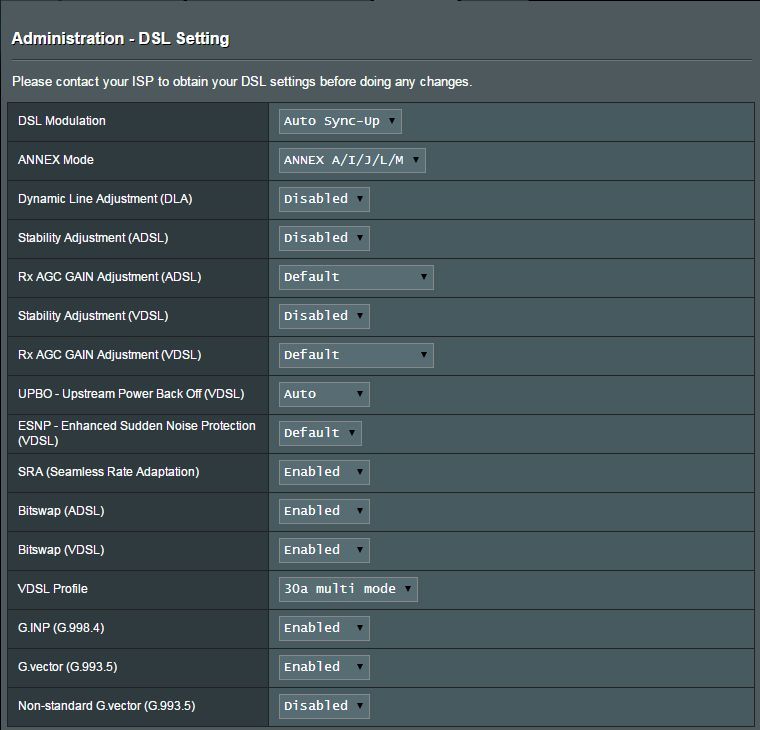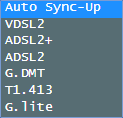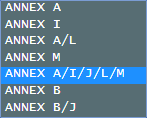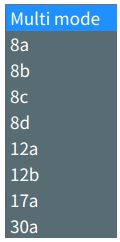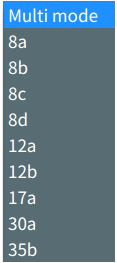Expired
XVI. DSL Diagnostics
Expired
What is VDSL Vectoring, SRA and G.INP ?
Vectoring
VDSL Vectoring is a method of increasing the speed of a given VDSL2 (G.993.2/FTTC) line so that it can achieve a higher speed than it would otherwise achieve. It does so by using noise cancelling technology to reduce interference from adjacent lines or other services or plant (equipment). Vectoring is defined by the ITU-T standard G.993.5.
Vectoring is distinct from G.998.4 (formlerly known as ‘G.INP’) which is another method of increasing immunity to spikes or bursts of EMF (Inpulse Noise) and also Seamless Rate Adaptation (SRA) which adjusts your rate according to current line conditions.
BT are calling vectoring a ‘speed enabling’ method rather than a ‘speed increasing’ method, which may seem semantic, but the goal is that they provide connectivity closer to the current 76Mb/s maximum for more users, rather than increase speed for users already running near to those speeds. In tests so far, users reported an increase of 10-15Mb/s when using Vectoring for lines which were previous running at 50-70Mb/s.
It’s not yet known what benefits Vectoring be gained to lines which run at much lower speeds due to line quality or length. VDSL is very much dependent on line length for its speed, which is why the cabinet and MSAN must be in your street or a nearby street (compared to ADSL which can run for miles from the exchange). VDSL lines longer than 500M see a significant fall-off in speed. at 1Km the speed can reach approximately 25Mb/s which is not very different to ADSL2+ Annex M. VDSL Vectoring is unliklely to provide much benefit to very long VDSL lines where the issue is attentuation, not just noise or crosstalk, though of course, the longer a line is, the more opportunities it has to suffer interference.
G.INP / G998.4
G.998.4 is a newer alternative to FEC (Forward Error Correction) and interleaving to providing a lower overhead (FEC loses about 12% whereas G.INP only corrects errors when they actually occur) so there is little overhead. G.998.4 was formerly known as G.INP and may also be referred to as Impulse Noise Protection or Physical Retransmission (PHY-R).
G998.4 operates at the physical layer. The transmitting modem keeps a copy of transmitted data in a retransmission buffer. If the receiver detects corruption (by way of a checksum) a retransmission is requested. If the transmitter responds in time, the data is repaired. The round-tip time of a retransmission should be <4ms. If the transmitter doesn’t retransmit in time, the corrupt data is forwarded for higher level protocols to sort out.
What if I have older products which don’t support vectoring or G.INP?
If you have an older product or any product which does not support vectoring or G.INP, then you will still be able to connect — it’s just that you just won’t see any benefit which you might have otherwise. In some cases, the telco may switch your line from a ‘fast’ profile to an ‘Interleaved’ profile, which has slightly higher latency.
What is latency?
Latency is the time taken for data to be received from a transmitting device — ie. for your data to get from the server you’re accessing, to your own PC. Latency is measured in ms (milliseconds), for example 95ms (which is just under 0.1 seconds). If you access a server on the other side of the world, the latency (transit time) will be higher than a server in the same country or city (depending on the actual route). Higher latency does not affect download or upload speeds (throughput) so you wouldn’t notice any effect on web browsing or multimedia, but you might care about it if you were an online gamer or financial trader, where a millisecond can make a material difference (i.e. getting fragged or losing a pip in the dollar/starling rate etc.)
What is interleaving?
Interleaving is a method of error correction used on DSL lines; an interleaved profile can be applied to a line to improve resilience (as opposed to a ‘fast’ profile) to burst of errors. Interleaving can add additional latency of up to 40ms depending on the maximum interleave depth that has been enabled on the line profile.
What is INP?
INP (Impluse Noise Protection) is a method of protecting against or correcting the effects of sudden bursts of noise on your line caused by adjacent equipment, lines or other interference. The value of INP (1,2,4 etc.) is the number of DTM symbols (each symbol is a segment of data representing bits as tones) that can be completely corrected for errors. The higher the INP the more resilient a line is to a burst of errors but at the cost of higher overall latency. The INP scheme used could be G.INP (G.998.4) or a traditional scheme based on Reed-Solomon coding and interleaving.
DrayTek Supporting Products
Various DrayTek models support Vectoring and G.INP — please check products’ individual specifications on this web site to check. You may also be able to download the latest firmware to add support — check the release notes.
VDSL Beyond 100Mb/s
VDSL does have profiles within the standard which theoretically will run at up to 200Mb/s by using wider bandwith. The current ’17a’ profile will run at up to 100Mb/s (in perfect lab conditions) but a 30a profile could run at up to 200Mb/s but in reality, even if any telcos introduce 30a operation, speeds are likely to be much lower (for example 140Mb/s on good lines).
FTTP (Fibre to the premises) will run much faster than copper but whereas FTTC (like ADSL) uses existing phone lines which run to almost all premises already, FTTP require each house of office to be newly wired with fibre — a costly exercise. In some countries (for example The Netherlands) new-build homes and offices are pre-wired with fibre and a fibre tray ready for you to drop your modem/router into.
- First Published: 23/06/2014
-
Last Updated: 22/04/2021
Продукт
DSL-AC3100, DSL-AC51, DSL-AC52U, DSL-AC55U, DSL-AC56U, DSL-AC68R, DSL-AC68U, DSL-AC750, DSL-AC88U, DSL-AC88U-B, DSL-AX82U, DSL-N16, DSL-N16U, DSL-N17U, DSL-N55U, DSL-N55U (VER.B1), DSL-N55U (VER.C1), DSL-N55U_C1, DSL-N55U_D1, DSL-N66U
[DSL роутер] Как настроить DSL?
Список возможностей:
- 01. DSL модуляция
- 02. ANNEX режим
- 03. Dynamic Line Adjustment (DLA)
- 04. Stability Adjustment (ADSL)
- 05. Rx AGC GAIN Adjustment (ADSL)
- 06. Stability Adjustment (VDSL)
- 07. Rx AGC GAIN Adjustment (VDSL)
- 08. UPBO — Upstream Power Back Off (VDSL)
- 09. ESNP — Enhanced Sudden Noise Protection (VDSL)
- 10. SRA (Seamless Rate Adaptation)
- 11. Bitswap (ADSL)
- 12. Bitswap (VDSL)
- 13. VDSL профиль
- 14. G.INP (G.998.4)
- 15. G.vector (G.993.5)
- 16. Non-standard G.vector (G.993.5)
Шаг 1. Подключите свой компьютер или устройство к маршрутизатору, запустите веб-браузер и введите http://router.asus.com, чтобы войти на страницу входа в маршрутизатор (веб-интерфейс)
Или
Шаг 2: Подключите свой компьютер к маршрутизатору через проводное соединение или Wi-Fi и введите LAN IP адрес LAN IP или для новых моделей URL http://www.asusrouter.com to the WEB GUI.
Пожалуйста, обратитесь к Как отрыть страницу настроек роутера (Web GUI) (ASUSWRT)? для получения информации.
Примечание: пожалуйста, ознакомьтесь со статьей Как войти в интерфейс роутера (ASUSWRT)
Шаг 3. Перейдите в [Администрирование]> [Настройки DSL].
Примечание: Прежде чем вносить какие-либо изменения, обратитесь к своему поставщику услуг Интернета (ISP), чтобы получить настройки DSL.
01. DSL Модуляции
Здесь Вы можете выбрать правильный тип модуляции. Если Вы не знаете точно, какой тип вам нужен, оставьте его как «Автосинхронизация» (значение по умолчанию).
02. ANNEX Режим
Пожалуйста, уточните Ваш ISP в Annex режиме Вашей линии. Если Вы не уверены, какой выбрать, попробуйте настроить «A/I/J/L/M». Если DSL LED не мигает после 60 секунд, пожалуйста, попробуйте выбрать «B/J» и проверьте снова.
03. Dynamic Line Adjustment (DLA)
Этот пункт поможет мониторить DSL линию и предоставляет более стабильную работу линии. На основе текущего состояния линии, будут приняты необходимые изменения. Однако, если Вы хотите настроить параметры самостоятельно, установите для него значение «Отключено».
04. Stability Adjustment (ADSL)
Этот пункт для ADSL режима. Вы можете выставить негативное значение для стабильной работы и позитивное значение для лучшей производительности. В противном случае мы рекомендуем вам не устанавливать высокое положительное значение. Обратите внимание, что этот пункт будет автоматически изменен, если включен «Dynamic Line Adjustment (DLA)».
05. Rx AGC GAIN Adjustment (ADSL)
Этот пункт настраивает GAIN Rx AGC (Auto Gain Control) для ADSL, если ADSL-соединение работает по-прежнему нестабильно после настройки параметра «Стабильность» (ADSL) и имеет некоторый CRC, Вы можете установить режим «Стабильный».
06. Stability Adjustment (VDSL)
Этот пункт позволяет настроить целевое значение SNR Margin для VDSL.
Примечание: DSL-AC88U, DSL-AC3100, and DSL-AC88U-B don’t support option «Stability Adjustment VDSL».
Пожалуйста, перейдите в «Системный журнал — Журнал DSL» и сначала найдите предел SNR в нисходящем направлении.
- Для DSL-AX82U
Этот пункт позволяет настроить целевое значение SNR Margin. Вы можете установить отрицательное значение, чтобы максимизировать производительность нисходящего потока. Но обратите внимание, что чем ниже значение, тем слабее маршрутизатор DSL-модема для защиты от шума в линии. Может произойти потеря синхронизации. Поэтому, пожалуйста, отрегулируйте правильное значение. Однако, если Ваше соединение xDSL нестабильно или не может установить соединение, установите положительное значение.
- Для других моделей в FAQ
Например, если нижняя граница SNR составляет 8 дБ, Вы можете установить 7 дБ или ниже, чтобы максимизировать производительность нисходящего потока, 4 дБ (максимальная производительность), но обратите внимание на меньшее значение, DSL-модем-маршрутизатор будет слабее защищать линейный шум . Поэтому может возникнуть перерыв, поэтому, пожалуйста, настройте его с надлежащим значением. Однако, если соединение VDSL нестабильно или не может установить соединение, для этого случая установите более высокое значение, например 9 дБ ~ 30 дБ.
07. Rx AGC GAIN Adjustment (VDSL)
Этот пункт настраивает GAIN Rx AGC (Auto Gain Control) для VDSL, если настройка параметра стабилизации (VDSL) по-прежнему не может получить желаемого значения. Постарайтесь установить Rx AGC GAIN Adjustment в режим высокой производительности. Однако, если Ваше VDSL-соединение неустойчиво и имеет некоторые CRC, тогда можно установить режим Stable.
08. UPBO — Upstream Power Back Off (VDSL)
Этот пункт позволяет вам управлять включением / отключением UPBO (выключение питания в прямом направлении) для VDSL. DSLAM может использовать UPBO для уменьшения мощности Tx Вашего модемного маршрутизатора xDSL. В некоторых случаях ненормальное управление UPBO из DSLAM может привести к возникновению проблемы синхронизации (например, недостаточно мощности Tx для синхронизации с минимальной скоростью). Таким образом, с помощью этой функции теперь Вы можете отключить UPBO и не будете зависеть от настройки DSLAM.
09. ESNP — Enhanced Sudden Noise Protection (VDSL)
Эта команда полезна для некоторых условий импульсного шума и для повышения стабильности линии. Обратите внимание, что этот пункт будет автоматически изменен, если включена «Dynamic Line Adjustment (DLA)».
10. SRA (Seamless Rate Adaptation)
Включите SRA (адаптация без перекодировки) для обеспечения согласованных скоростей передачи данных и для предотвращения слабого и низкого соединения, но понижающая / повышающая скорость будет несколько уменьшена.
Однако, если Ваше соединение очень стабильно, и Вы заметили снижение скорости загрузки, Вы можете отключить SRA.
11. Bitswap (ADSL)
Этот элемент активирует функцию Bitswap. Он регулирует биты, распределенные для бинов/ каналов.
Занятым или переполненным бинам/ каналам назначается меньшее количество битов, а доступным каналам выделяется больше битов для обработки.
12. Bitswap (VDSL)
Этот элемент активирует функцию Bitswap. Он регулирует биты, распределенные для бинов/ каналов.
Занятым или перегруженным бинам/ каналам назначается меньшее количество битов, в то время как доступным каналам выделяется больше битов для обработки
13. VDSL Profile
Этот элемент настраивает профиль VDSL, который будет использоваться для VDSL, и его по умолчанию является многорежимный режим 30a, который совместим с режимом 17a / 12a / 8a. Однако для того, чтобы обойти нестандартную 30а многомодовую синхронизацию VDSL DSLAM, развернутую некоторыми немецкими провайдерами, установить значение 17a может потребоваться многорежимный режим, чтобы линия VDSL синхронизировалась. Для пользователей других стран нет необходимости изменять этот параметр. 8a многорежимный предполагает 8a, 8b, 8c и 8d, 12a многорежимный означает 12a и 12b.
Мультирежим совместим со всеми режимами.
Примечание: DSL-AX82U может поддерживать профиль 35b.
14. G.INP (G.998.4)
G.INP означает защиту от импульсного шума. Он работает только с ADSL2, ADSL2 + и VDSL2. Он позволяет обеспечить улучшенную защиту от импульсных помех или повысить эффективность обеспечения защиты от импульсного шума. Если Ваша DSLAM не поддерживает его, отключите его.
15. G.vector (G.993.5)
При использовании G.vector перекрестные помехи между сигналами в одном кабеле могут быть отменены, например, перекрестные помехи на дальнем конце (FEXT). Это значительно улучшает соотношение сигнал-шум (SNR), что приводит к более высоким достижимым скоростям передачи. Однако ISP должен развернуть векторный DSLAM VDSL2, чтобы эта функция работала. Если Вы обнаружите, что функция не работает, или Вы знаете, что G.vector Вашего провайдера нестандартен, включите оба варианта и нестандартный G.vector.
16. Non-standard G.vector (G.993.5)
Этот пункт поддерживает нестандартный G.vector для определенных стран. Обратите внимание: если Вы знаете, что G.vector Вашего провайдера является стандартным, пожалуйста, НЕ включайте этот параметр для оптимизации производительности.
Связанные часто задаваемые вопросы
Почему в моем профиле VDSL маршрутизатора нет опции 35b?
Только DSL-AX82U может поддерживать профиль 35b.
Как скачать (Утилиты / ПО)?
Вы можете загрузить последние версии драйверов, программного обеспечения, микропрограмм и руководств пользователя из Центра загрузок ASUS.
Узнать больше о Центре загрузок ASUS можно по ссылке.
Updated February 2021. A major enhancement called G.INP has been introduced to my fibre broadband FTTC connection, as part of BT’s rollout of a new technology aimed at improving fibre broadband speeds and reducing errors. In this article, I look at G.INP and its benefits, and show how you can tell if this technology has been implemented on your line. G.INP appears to significantly improve lines affected by crosstalk interference, even in the absence of vectoring!
In the past, some modems (e.g. the BT Home Hub 5 Type A) have been incompatible with the full implementation of G.INP, but the current situation (as of 2021) is more stable. BT had to remove G.INP on the uplink across its network but G.INP on the downlink provides significant improvements in downlink speed. It has taken Openreach some time to roll our G.INP across its network.
From 74 Mbps to 80 Mbps downlink connection speed as G.INP is switched on
I had a pleasant surprise yesterday morning as I looked at the front status page of my Billion 8800NL modem router (shown above), and that was a significant improvement in download speeds due to the switch-on of a fibre broadband enhancement called ‘G.INP’. Furthermore, the number of errors on my line have decreased significantly.
Readers of the recent article Early Deployment of Vectoring is Essential to Avoid a Crosstalk Crisis with FTTC Fibre Broadband will know that my FTTC line has increasingly suffered from crosstalk as the penetration of fibre broadband has increased in my village. Internet forums are awash with similar stories. I was the first person in my village to have fibre broadband installed, and the initial downlink connection speed was 80 Mbps, with a maximum attainable rate of 145 Mbps. Since then, downlink connection speed has declined with increasing fibre broadband take-up, which now stands at well over 50% of premises. With crosstalk, the download connection speed had dropped to 74 Mbps. Yesterday, download connection speed went back to 80 Mbps with G.INP switched on – a significant speed improvement without any noticeable change in latency (ping times). Although vectoring is seen as the key technical solution for combatting crosstalk, these results suggest that G.INP can really help to mitigate the effects of crosstalk in the absence of vectoring.
Introduction to G.INP: retransmission of packets
G.INP introduces a much-needed additional feature to the Digital Line Management (DLM) capabilities of the fibre street cabinet to better (and more efficiently) cater for all types of line condition.
G.INP is an enhancement that makes fibre broadband signals significantly less sensitive to sporadic noise and interference, to maximise broadband speeds. This enhancement is so significant that Huawei describes G.INP as a “new technology” that gives DSL “a fresh lease of life”.
Fibre broadband signals travelling along copper wires are highly susceptible to impulse noise and interference. For example, appliances with power adapters, power switches and electric motors can cause significant degradation to broadband signals and I have had plenty of personal experiences of this happening, so no doubt this is a common occurrence among broadband users.
As an example, a faulty power supply on a DVD player caused the broadband connection of most people within my street to drop sporadically for several weeks (before the problem player was identified). A new LCD monitor that I had purchased caused regular disconnections and significant declines in my broadband speeds before I put two and two together and identified the cause of the problem. As yet another example, an old central heating thermostat in my hall used to cause my modem to drop its connection every single time the house reached its target temperature (before it was replaced). Such sources of noise and interference can be frustratingly difficult to identify and remedy, particularly if they are beyond your control.
As described in our crosstalk interference article, fibre broadband signals are also susceptible to interference from other fibre broadband signals carried along nearby copper wires – called crosstalk interference. Although vectoring is seen as a core technology for combatting crosstalk, our results with G.INP suggest that G.INP can help to mitigate the effects of crosstalk interference. This will be welcome news since vectoring has not yet been rolled out nationwide.
It is important that errors caused by noise and interference are minimised with fibre broadband, particularly as some services (e.g. video) are particularly sensitive to packet loss or errors.
Up until the introduction of G.INP, BT has had to rely on two approaches to address noise and interference issues:
- reducing the download and upload speeds, to improve the signal-to-noise and signal-to-interference ratio
- applying interleaving and error correction, which reduce throughputs and introduce extra delay (or latency).
These approaches can significantly degrade the actual throughputs of a fibre broadband connection. They are simply not suited to mitigating noise/interference that is infrequent and sporadic in nature since they apply to the whole duration of a connection rather than the short duration of a noise ‘event’. Sporadic occurrences of noise are termed Single High Impulse Noise Events (SHINE), and may occur when a particular appliance is turned on or off, for example.
The ITU-T has developed a technical standard – called G.INP (also known as ITU G.998.4)– that is specifically designed to mitigate sporadic occurrences of noise and interference. G.INP introduces an efficient data packet retransmission capability to broadband systems. With G.INP, data packets that are affected by sporadic noise and interference are simply resent.
G.INP allows a fibre broadband line to generally sync higher than without G.INP since it provides the mechanism for retransmitting the occasional lost data packet without having to lower connection speeds or introduce interleaving.
‘Efficiency’ is the key word with G.INP
For many broadband connections, reducing connection speeds and introducing interleaving and coding to combat sporadic noise and interference are simply overkill and inefficient (and cause unnecessary performance degradation).
If a fibre broadband connection suffers infrequent noise ‘spikes’ at certain times of the day (for example, caused by a faulty central heating thermostat), only a tiny proportion of the data packets sent during the day may be affected. Reducing connection speeds and/or introducing interleaving and coding to try to combat this could noticeably degrade the broadband connection for the entire connection period.
With interleaving, the original sequence of data packets is chopped up and rearranged so that packets that were originally together are spaced out in time to make them less sensitive to noise and interference bursts. At the other side of the connection, these packets are put back together in their original order. Interleaving inherently introduces time delay, since a particular packet may have been rearranged to be sent at a significantly later time, and there is an additional processing delay at the other end of the connection when all the received packets have to be reassembled in their original order. According to BT, interleaving can increase the latency of a connection by up to 40 ms, which can “adversely affect some delay-sensitive applications”, such as online gaming and voice telephony (e.g. Skype).
With interleaving, all packets are delayed, irrespective of how many are affected by noise and interference. If noise and interference is sporadic, it makes much more sense to retransmit only the affected packets (i.e. using G.INP) than introduce latency to all the packets sent. For many fibre broadband connections, G.INP may be perfectly adequate on its own to efficiently maintain a connection with low error rates without the need for interleaving or reduced speeds.
G.INP in BT’s fibre broadband network
BT Openreach has already carried out successful trials of G.INP, and is now in the process of rolling out G.INP in its fibre broadband network. An increasing number of broadband users on Internet forums are reporting that G.INP has gone live on their connections.
The extent to which G.INP will be rolled out to BT’s entire network is currently unknown, as is the status of vectoring deployment. G.INP roll-out may take several months. However, the initial deployment of G.INP is clearly great news as G.INP does seem to significantly lower error rates and increase connection speeds without the latency penalty seen with interleaving. It also seems to be effective at combatting crosstalk interference – not just sporadic impulse noise.
How to tell G.INP is operational on your line
It’s not exactly obvious when G.INP has been enabled, and statistics provided by your modem may be somewhat limited and confusing. There is much confusion about G.INP currently on Internet forums, with broadband users unsure whether their line is G.INP-enabled or not.
For those with modems that do not support G.INP (for example, the BT Home Hub Type A), the Billion 8800NL (or Billion 8800AXL) makes a superb upgrade.
Please note that due to incompatibilities of some modems, BT has removed G.INP on the uplink across its network but, most importantly, G.INP is operational on the downlink to provide significant improvements in downlink speed.
It is possible to tell that G.INP has been implemented from your modem statistics, and the screen shot below shows the statistics page for the Billion 8800AXL. You can detect the existence of G.INP if the INP (DMT symbol) value is set to 48.0, with an interval depth or 8 or 16.
Other pages you may be interested in are:
Increase Broadband Speed Guide to squeeze the highest speed from your broadband connection
Wi-Fi Optimisation Guide – how to improve your WiFi connection and speeds
Early Deployment of Vectoring is Essential to Avoid a Crosstalk Crisis with FTTC Fibre Broadband
What is G.fast?
Chart of BT FTTC Speeds Versus Distance From the Street Cabinet
What is G INP VDSL?
INP (ITU G. 998.4) is an error correction solution that is designed to help resolve spikes of Electromagnetic Interference (impulse noise), which can improve a line’s stability and thus performance. The introduction of this technology can, on some VDSL2 lines, even produce a small increase in service speed.Feb 13, 2020
What is G Vectoring VDSL?
VDSL Vectoring is a method of increasing the speed of a given VDSL2 (G. 993.2/FTTC) line so that it can achieve a higher speed than it would otherwise achieve. It does so by using noise cancelling technology to reduce interference from adjacent lines or other services or plant (equipment).
Which is better VDSL or fiber?
VDSL provides a dedicated line and a more reliable internet experience than ADSL, our basic broadband service, and is available today to 80 percent of the country right now. … Fibre is the best broadband on our network, providing a consistently reliable connection along with ultra-fast speeds.
What is SRA in router?
SRA software allows modems to make seamless data transfer rate changes to avoid dropping a connection. Modems are affected by cross talk from adjacent lines, as well as by other interference such as temperature changes and radio signals.
What is SOS in router?
SOS is a network overlay, composed of nodes that communi- cate with one another atop the underlying network substrate. Often, nodes will perform routing functionality to deliver messages (pack- ets) from one node in the overlay to another. … In effect, no node’s identity is kept hidden.
Does my line support vectoring?
You can check to see if your line has vectoring activing by looking for the words «Vectoring Active» in the VDSL2 Information section of the [Online Status] page as shown in the screenshot below.
What’s the difference between VDSL and ADSL?
ADSL (Asymmetric Digital Subscriber Line) uses copper telephone wires for transmitting digital information such as data, audio and video, at a high bandwidth. … VDSL (Very high bit rate digital subscriber line) is a newer technology. Like ADSL, VDSL uses your copper phone line, but delivers a faster connection speed.Nov 11, 2015
What is super vectoring router?
Compared to normal Vectoring, Supervectoring increases the frequency spectrum from 17 MHz to 35 MHz. Especially over short distances, this results in a significant speed gain of up to 300 Mbps between the distribution box and the router.
What is vectoring used for?
Vectoring technology has emerged as a means of increasing broadband speeds without investing in an extensive fibre roll-out. The technology uses noise cancellation, in a similar way to noise-cancelling headphones, to increase data speeds on existing copper infrastructure.Mar 1, 2012
Related
Is VDSL fast?
VDSL is very fast broadband. By definition, VDSL is faster than traditional ADSL broadband, because VDSL is a mix of fibre and copper infrastructure. It’s around 3x faster than ADSL broadband, and it has much better upload speeds.
Related
Is VDSL an NBN?
IS VDSL THE SAME AS NBN? No, put simply a VDSL is a type of modem. You will need a VDSL modem to access the high speed nbn service if you do not have a DSLAM attached to your premises. If you do have a DSLAM attached, then you will want your modem to have WAN port to connect to the internet source.Jul 24, 2018
Related
Is VDSL faster than 4G?
ADSL or VDSL — regular broadband capable of high speeds. 3G/4G — fast, wireless mobile network. … Local wireless networks — fast networks available in specific areas. Fibre — delivers fastest speeds through an optic cable.
Related
Is converge fiber or DSL?
Service areas. Converge ICT serves fiber optic Internet access in Metro Manila, Calabarzon, Central Luzon and several parts of the Bicol and Ilocos regions, and continues to expand its coverage across the country.
Related
Is VDSL faster than fiber?
VDSL is not the same as fiber internet. VDSL stands for very high-speed digital subscriber line. It’s a faster version of DSL internet, operating over the copper wires of a landline phone network and meeting theoretical top speeds of 70 Mbps. Fiber runs over fiberglass cabling, not phone wires.Nov 10, 2021
Related
What is ginp and how does it work?
-
With G.INP, data packets that are affected by sporadic noise and interference are simply resent. G.INP allows a fibre broadband line to generally sync higher than without G.INP since it provides the mechanism for retransmitting the occasional lost data packet without having to lower connection speeds or introduce interleaving.
Related
What is the use of InP (error protection)?
-
G.INP is an Error Protection method which helps prevent the loss of data in the event of noise bursts by using a retransmission buffer at the physical layer. (In the Modem/Router/DSLAM).
Related
What is INP (Impluse noise protection)?
-
What is INP? INP (Impluse Noise Protection) is a method of protecting against or correcting the effects of sudden bursts of noise on your line caused by adjacent equipment, lines or other interference.
Причин разрывов ADSL соединения (линка) может быть довольно много, кроме того может быть совокупность нескольких факторов, приводящих частому падению линка. Не все из них всегда возможно устранить, но можно попытаться уменьшить их влияние. В этой статье рассмотрим настройки ADSL модема на примере Zyxel P660HTN EE. Почти все настройки будем делать из командной строки (CLI), через telnet соединение. Как его настроить можно прочитать в этой статье.
Возможные причины разрывов ADSL
Первым делом необходимо посмотреть на параметры линии. Учтите, что у входящего (downstream) и исходящего (upstream) канала свои собственные параметры, но как правило они не очень сильно отличаются.
1) Затухание в линии (Attenuation) должно быть не более 45 dB. Если значение больше 60 dB, то ADSL работать не будет.
2) Соотношение сигнал/шум (Noise Margin) должно быть более 6 dB.
Проверить эти параметры можно командой wan adsl l n для downstream и wan adsl l f для upstream.
Если эти параметры не выполняются, то проверьте:
- Правильно ли включен сплиттер (при наличии телефона).
- Нет ли повреждений на проводе.
- Доступные вам места соединения телефонной линии.
В местах соединения проводов не должно быть коррозии и плохо закрепленных контактов. Линия должна быть выполнена из одножильных проводов и следует учесть, что чем меньше точек соединения, тем лучше характеристики линии. Если в квартире все подключено верно и линия в хорошем состоянии, то стоит обратиться в поддержку провайдера. Чтобы они устранили проблемы на линии.
Вторая причина может быть в модеме. Возможен брак модема, брак блока питания модема, а также параметры бытовой электросети. Если имеют место скачки напряжения, то стоит подумать о трансформаторе для модема. Также, можно проверить работу на другом модеме, одолжить на время у друга или попросить у провайдера для теста. Если от замены модема мало что поменялось, то скорее тут третья причина.
Третья причина — это несогласованность/несовместимость настроек оборудования провайдера и модема. Именно эту причину и попробуем устранить, на примере модема Zyxel. У него довольно богатый набор команд для настройки и диагностики соединения, кроме того команды универсальны и подходят к большинству модемов Zyxel, за редким исключением.
Четвертая причина актуальная для модемов Zyxel. Это активированная технология поддержания максимальной скорости на линии. Что бы проверить это, подключитесь к модему через telnet и введите команду sys view autoexec.net — посмотреть команды в автозапуске модема. Если в автозапуске присутствует строчка wan adsl rateadap on или wan adsl rate on, то значит эта технология активирована. Для ее отключения нужно заменить строчки на wan adsl rateadap off и wan adsl rate off соответственно. Русскоязычная техподдержка Zyxel почему-то уверена, что эти команды управляют механизмом SRA, хотя это не так. Подробное описание команд можно посмотреть в статье «Команды для ADSL модемов Zyxel».
Краткая теория
Во-первых, следует уяснить, что соотношение сигнал/шум (noise margin) величина изменяющаяся со временем, например, от появления/исчезновения помех других абонентов в магистральном кабеле или радиопомех. Так же, нужно понимать, что чем больше значение noise margin, тем меньше скорость. То есть, выше скорость — хуже стабильность соединения и наоборот.
Во-вторых, пока у линии не будут приемлемые параметры затухания вы не получите стабильной работы ADSL, тут надо менять линию, а не настройки.
В-третьих, изменять параметры соединения вы сможете только для входящего канала (downstream), параметры исходящего канала как правило определяются только DSLAM и версией Annex выставленной на модеме.
Включаем механизм SRA
SRA (Seamless Rate Adaptation) позволяет изменять скорость соединения «на лету», таким образом адаптируясь к изменениям в линии, не дожидаясь разрыва.
Модем настроен в режиме моста, опытным путем выяснил, что соединение держится стабильно при автоматической синхронизации, то есть когда разрешены все стандарты ADSL и все виды Annex.
Теперь следует выяснить какой профиль настроен на порту DSLAM. Для этого необходимо подключится к модему через telnet и ввести команду: wan dmt2 show cmsg1. В ответ вы получите настройки профиля на DSLAM.
Важный параметр здесь RA-MODEds, он может иметь три варианта:
- RA-MODEds = 1 (FIXED DATARATE) — фиксированная скорость соединения, как правило урезанная провайдером, до более менее стабильного соединения.
- RA-MODEds = 2 (RATE ADAPTIVE AT INIT) — скорость соединения согласуется при старте и не меняется до следующего разрыва.
- RA-MODEds = 3 (DYNAMIC RATE ADAPTATION) — скорость соединения меняется в процессе работы.
Механизм SRA будет работать только с динамическим профилем. Поменять профиль на динамический может только провайдер. Лучше всего подавать заявку в письменном виде, потому что как только первая линия ТП увидит незнакомые слова, скорее всего отправит вопрос специалистам. Для простоты общения, лучше сразу написать все параметры в профиле. Например, такие:
TARSNRMds = 70 dB (желаемый уровень сигнал/шум = 7 dB)
MINSNRMds = 10 dB (минимальный уровень сигнал/шум = 1 dB)
MAXSNRMds = 310 dB (Excess margin need not to be minimized) (максимальный уровень сигнал/шум = 31 dB)
RA-MODEds = 3 (DYNAMIC RATE ADAPTATION) (Тип профиля DSLAM, динамическая адаптация скорости)
PM-MODEds = 1 0 (L2 is allowed) (L3 not allowed) (Разрешенные режимы энергосбережения)
RA-USNRMds = 85 dB (уровень сигнал/шум при достижении которого произойдет повышение скорости)
RA-UTIMEds = 20 sec (время в течении которого сигнал/шум должен быть больше или равен RA-USNRMds, чтобы произошло повышение скорости)
RA-DSNRMds = 60 dB (уровень сигнал/шум при достижении которого произойдет понижение скорости)
RA-DTIMEds = 20 sec (время в течении которого сигнал/шум должен быть меньше или равен RA-DSNRMds, чтобы произошло понижение скорости)
BIMAXds = 15 bit
EXTGIds = 0 dB
CA-MEDLEYus = 6144 symbols(min)
Reserved1 = 0 (Should be 0)
Далее несколько “если”.
Если задержки (ping) не критичны, то лучше поставить канал в режим interleave, при этом нужно задавать задержку в миллисекундах, например, 8мс. Задержка должна быть одинакова для downstream и upstream. Это позволит корректировать ошибки при передаче ячеек и увеличит стабильность соединения.
Стоит попросить задать параметры INP, для плохих линий стоит задать значение INP min = 1 или больше. INP задается отдельно для downstream и upstream.
Если спросят, то максимальные скорости для downstream и upstream каналов можно поставить по максимуму 24000 кбит/с и 3500 кбит/сек соответственно.
Далее со своей стороны нужно убедится в том что SRA в модеме включено. Делается это командой wan dmt2 set olr 4. В ответ вы получите current state: OLR ON, SRA ON. Из личного опыта обнаружил, что строчка wan dmt2 db tlb 10 в списке autoexec.net мешает корректной работе SRA и её необходимо удалить оттуда.
Ниже пример содержимого моего автозапуска, при котором, модем стабильно держит линию по 30 — 70 часов. К сожалению, SRA не панацея, от резких и глубоких изменений характеристик линии она не спасёт.
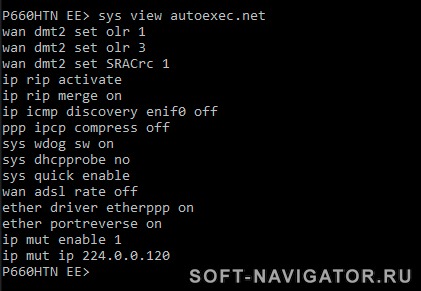
Что делать если нет SRA
Если по каким-то причинам не удается получить от провайдера динамический профиль с корректными настройками, то можно поменять некоторые настройки, со своей стороны для downstream канала.
Можно попробовать отключить Annex M, так как он предъявляет повышенные требования к качеству линии.
Также, в модемах Zyxel есть возможность смещать соотношение сигнал/шум в большую или меньшую сторону. Смещение задается командой wan dmt2 set snrmoffset Х Y , где X или Y значение полученное по формуле: 1280-(±Z*512).
- X — задает смещение для режима Fast;
- Y — задает смещение для режима Interleave;
- Z — значение смещения в dB.
Например, для увеличения соотношения сигнал/шум на +1 dB получим значение 1280-512=768, следовательно, команда будет выглядеть wan dmt2 set snrmoffset 768 768.
Таким образом, можно подобрать оптимальное соотношение сигнал/шум.
Для того чтобы нужные команды сохранялись после перезагрузки модема их нужно прописать в автозапуск. Вводим команду sys edit autoexec.net, затем кнопкой N листаем и в нужном месте нажимаем кнопку i, вставляем нужную команду и нажимаем Enter . Для сохранения нажимаем кнопку X. Местоположение команд в автозапуске относительно друг друга имеет значение. Предположительно, команды, расположенные в конце, имеют более низкий приоритет, чем те что в начале.
Команды не для всех
Если провайдер не хочет менять параметры профиля, то можно попробовать изменить некоторые параметры самостоятельно. Эти команды работают не для всех модемов, но попробовать стоит.
w dmt2 set INP V, где V — значение INP_min
wan dmt2 set path 1 — установить режим канала Interleave.
wan dmt2 set txfltrgain 7FFFF — вероятно смещает точку усиления диапазона частот, может принимать значения от 00000 до FFFFF (7FFFF- середина диапазона).
Чтобы проверить результат нужно сбросить соединение командой wan adsl reset.
Если в логах модема вы заметили, что firewall часто пишет об атаке сканирования портов, и при этом модем настроен в режиме моста, то в таком случае лучше отключить firewall в модеме. Дело в том, что в качестве защиты от сканирования портов модем может блокировать трафик или его часть, это может приводить к разрывам. На безопасность это особо не повлияет, так как в режиме моста используется межсетевой экран узла на котором устанавливается PPPoE соединение.



